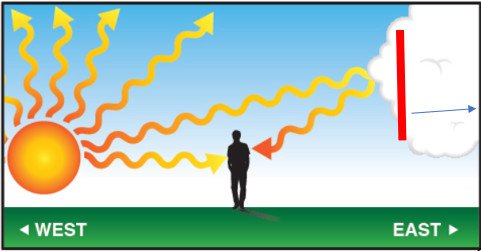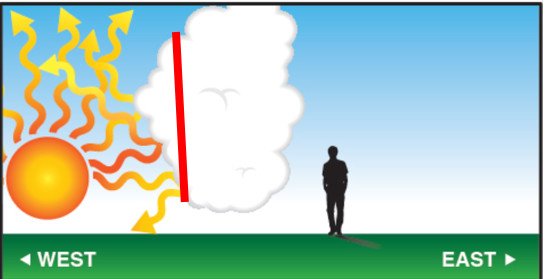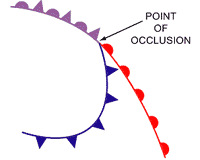Red Sky at Night, Shepherd’s Delight
“Red sky at night, shepherd’s delight. Red sky in the morning, shepherd’s warning” (or sailors rather than shepherds, depending on where in the country you are).
Is there any truth in this saying and, if so, why?
COMMON MISCONCEPTION: SOMETIMES THERE IS CONFUSION ABOUT THIS SAYING. IT IS TRUE THAT WHEN THE AIR IS ‘DIRTY’ – EITHER WITH POLLUTANTS FROM INDUSTRY, VEHICLES ETC OR WITH VOLCANIC ASH, SUNSETS AND SUNRISES TEND TO BE MORE SPECTACULAR. THESE CONDITIONS ARE ENHANCED BY HIGH PRESSURE, WHICH WE ASSOCIATE WITH CLEAR SKIES AND THEREFORE WARM, SUNNY WEATHER IN THE SUMMER, COLD, CRISP WEATHER IN THE WINTER (AND GLOOMY OVERCAST WEATHER IN THE LATE WINTER AND SPRING). HOWEVER, THIS IS NOT THE EXPLANATION OF THIS SAYING, BECAUSE HIGH PRESSURE TENDS TO LAST FOR SEVERAL DAYS.
You can find the Students’ Worksheet here.
Low pressure weather systems (depressions) bring us rain, strong winds and sometimes snow on high ground. Sometimes, they also bring thunder, lightning and even tornadoes to the UK. Neither shepherds nor sailors like this sort of weather.
1) Red sky at night
Imagine you are standing on the ground with the Sun setting (remember the Sun rises in the east and sets in the west).
Our weather tends to come from the west. Let’s consider a weather system which has already passed us first, moving from west to east – the diagram shows the clouds associated with the weather system and the direction they are moving.
The wiggly red lines represent the Sun’s light – if the light can reach you, then you can see the Sun. At sunset and sunrise the Sun appears red.
a) Looking at the diagram, are you going to be able to see the sunset? ___Yes______________
b) Why? _Light can get from the Sun to you_____________
Light is reflected by the water droplets in a cloud. This means that some of the light heading towards the cloud is reflected back in the direction it came from. If this light can reach you, then you’ll see the cloud lit up by the setting Sun.
c) Looking at the diagram, are you going see the cloud lit up by the setting Sun? ___Yes____________
d) Why? ____The sunlight will reflect back from the cloud to you______
e) Shade the side of the cloud which will appear red.
Now consider a weather system which hasn’t reached us yet:
f) Looking at the diagram, are you going to be able to see the sunset? ____No______________
g) Why? __The cloud is in the way – sunlight can’t reach you________
h) Looking at the diagram, are you going see the cloud lit up by the setting Sun? ___No_____
i) Why? ___The side of the cloud lid up by the Sun is on the further side, which you cant see.____
j) Shade the side of the cloud which will appear red.
Weather systems are usually a few days apart – if a weather system has just passed us, we probably won’t get another one the same day. If a weather system is in sight, it will probably bring bad weather to us shortly.
In your own words, explain how these diagrams explain “red sky at night, shepherd’s delight”.
__If a storm has just passed, you’ll be able to see the sunset and the cloud illuminated by the sun, giving a red sky. If a storm has just passed, it’s unlikely that there will be another one tomorrow, so the weather is likely to be good. On the other hand, if you can’t see the setting sun or the illuminated side of the cloud, the sky won’t look red at sunset – this is the case when the cloud from an approaching storm is between you and the Sun, and bad weather is on the way.___






